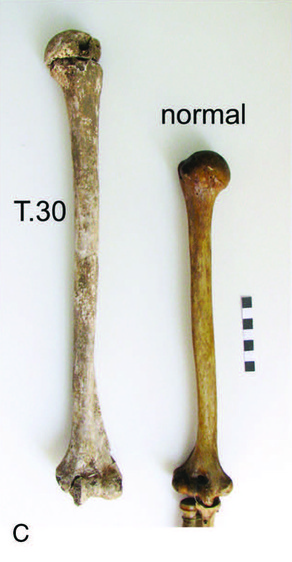 A comparison of the humerus (upper arm bone) from a skeleton of an individual with pituitary gigantism (T.30) with a "normal" male from Ancient Rome (taken from Figure 1 of Minozzi et al. 2012).
A comparison of the humerus (upper arm bone) from a skeleton of an individual with pituitary gigantism (T.30) with a "normal" male from Ancient Rome (taken from Figure 1 of Minozzi et al. 2012). The authors note several things about the remains:
- the large size of the bones (long bone lengths over 5 standard deviations from the mean of the population)
- hyperostosis (thickening) of the frontal bone of the skull
- enlargement of the area inside the skull where the pituitary gland would have been
- a wide and long mandible
While the amount of dental wear and the stage of fusion of the cranial sutures were consistent with an individual over the age of 20, it is clear that some of the long bones and vertebrae had not yet stopped growing. In combination with a presumed enlarged pituitary gland, the large size of the bones and their apparent delayed fusion suggests an overgrowth syndrome (a genetic disorder associated with abnormal body growth) that began during childhood.
The authors state that “this case represents an extraordinary discovery, for the first time documenting gigantism in a complete ancient skeleton.” The paper has a nice figure showing the humerus and tibia in comparison to corresponding bones from a “normal” male (giantologists: note the presence of a scale and the plan view perspective of the photograph that makes it clear how big the bones actually are). The short length of the paper means it contains frustratingly few details, however: there is no explanation of how stature was estimated, no metric data are provided, and we are not given much information about which epiphyses are incompletely fused (some do not fuse completely until after age 20 under normal circumstances).
*Minozzi, Simona, Walter Pantano, Franceso di Gennaro, Gino Fornaciari, and Paola Catalano. 2012. Pituitary Disease from the Past: A Rare Case of Gigantism in Skeletal Remains from the Roman Imperial Age. The Journal of Clinical Endocrinology and Metabolism 97(12):4302-4303.


 RSS Feed
RSS Feed
